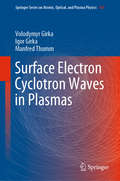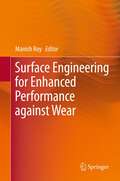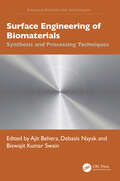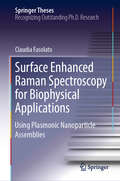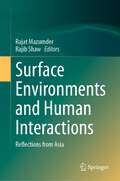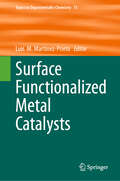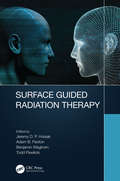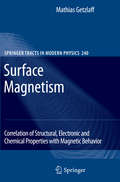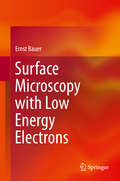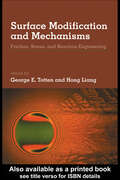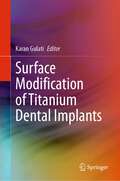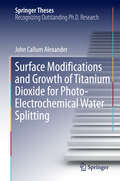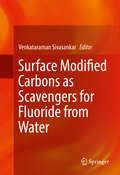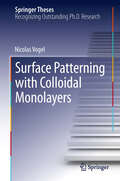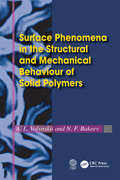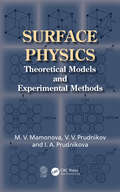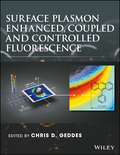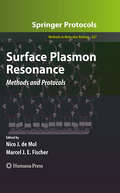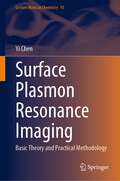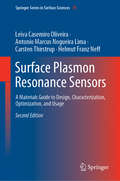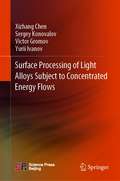- Table View
- List View
Surface Electron Cyclotron Waves in Plasmas (Springer Series on Atomic, Optical, and Plasma Physics #107)
by Volodymyr Girka Igor Girka Manfred ThummThis book is the first of its kind devoted to surface waves propagating across an external static magnetic field at harmonics of the electron cyclotron frequency. Based on comprehensive theoretical studies carried out over the course of about forty years, it presents unique material on various characteristics of these transverse waves, namely, dispersion properties and their dependence on numerous design peculiarities of plasma waveguides; damping due to interaction with the plasma surface (the kinetic channel) and collisions between plasma particles (the Ohmic channel); interaction with flows of charged particles moving above the plasma surface; parametric excitation due to the effect of an external radiofrequency field; and their power transfer for sustaining gas discharges. Clarifying numerous complicated mathematical issues it is a valuable resource for postgraduate students and experts in plasma physics, electromagnetic waves, and the kinetic theory of plasmas.
Surface Engineering and Functional Nanomaterials for Point-of-Care Analytical Devices
by Pranjal Chandra Buddhadev PurohitThis book chronicles the role of advanced nanomaterials and surface engineering technologies in the development of point-of-care biosensors for health and environmental monitoring. All aspects of nanomaterial synthesis and characterization, functionalization methods, sensing surface engineering, signal amplification strategies, use of innovative technologies to enhance sensor efficiency and performances, and innovative applications of nanobiosensors to tackle real-life problems are discussed in this book with a focus on optical and electrochemical based sensing. It also covers the detection of infectious diseases and various disease biomarkers, smartphone-based biosensing, and portable diagnostics module developments with a discussion on the working mechanisms of these devices in various domains. The book also illustrates the recent trends in biosensing, and an overview of the challenges and probable solutions for the translation of biosensors from laboratory prototypes to commercial success.
Surface Engineering for Enhanced Performance against Wear
by Manish RoySurface Engineering constitutes a variety of processes and sub processes. Each chapter of this work covers specific processes by experts working in the area. Included for each topic are tribological performances for each process as well as results of recent research. The reader also will benefit from in-depth studies of diffusion coatings, nanocomposite films for wear resistance, surfaces for biotribological applications, thin-film wear, tribology of thermal sprayed coatings, hardfacing, plating for tribology and high energy beam surface modifications. Material scientists as well as engineers working with surface engineering for tribology will be particularly interested in this work.
Surface Engineering of Biomaterials: Synthesis and Processing Techniques (Emerging Materials and Technologies)
by Debasis Nayak Ajit Behera Biswajit Kumar SwainSurface engineering provides one of the most important means of engineering product differentiation in terms of quality, performance, and lifecycle cost. It is essential to achieve predetermined functional properties of materials such as mechanical strength, biocompatibility, corrosion resistance, wear resistance, and heat and oxidation resistance. Surface Engineering of Biomaterials addresses this topic across a diverse range of process technologies and healthcare applications. Introduces biomaterial surface science and surface engineering and includes criteria for biomaterial surface selection Focuses on a broad array of materials including metals, ceramics, polymers, alloys, and composites Discusses corrosion, degradation, and material release issues in implant materials Covers various processing routes to develop biomaterial surfaces, including for smart and energy applications Details techniques for post-modification of biomaterial surfaces This reference work helps researchers working at the intersection of materials science and biotechnology to engineer functional biomaterials for a variety of applications.
Surface Enhanced Raman Spectroscopy for Biophysical Applications: Using Plasmonic Nanoparticle Assemblies (Springer Theses)
by Claudia FasolatoThe book explores the phenomenon of surface-enhanced Raman scattering (SERS), the huge amplification of Raman signal from molecules in the proximity of a metallic nanostructured surface, allowing readers to gain an in-depth understanding of the mechanisms affecting the spectroscopic response of SERS-active systems for effective applications. SERS spectroscopy is an ultrasensitive analytical technique with great potential for applications in the field of biophysics and nanomedicine. As examples, the author presents the design of nanocolloid-based SERS-active substrates for molecular sensing and of a folate-based SERS-active nanosensor capable of selectively interacting with cancer cells, enabling cancer diagnostics and therapy at the single-cell level. The author also suggests novel paths for the systematization of the SERS nanosystem design and experimental protocols to maximize sensitivity and reproducibility, which is essential when real-world biomedical applications are the goal of the study. With a combined approach, both fundamental and applied, and a detailed analysis of the state of the art, this book provides a valuable overview both for students new to SERS spectroscopy and for experts in the field.
Surface Enhanced Raman Spectroscopy: Analytical, Biophysical and Life Science Applications
by Sebastian Schlücker Wolfgang KieferCovering everything from the basic theoretical and practical knowledge to new exciting developments in the field with a focus on analytical and life science applications, this monograph shows how to apply surface-enhanced Raman scattering (SERS) for solving real world problems. From the contents: * Theory and practice of SERS * Analytical applications * SERS combined with other analytical techniques * Biophysical applications * Life science applications including various microscopies Aimed at analytical, surface and medicinal chemists, spectroscopists, biophysicists and materials scientists. Includes a Foreword by the renowned Raman spectroscopist Professor Wolfgang Kiefer, the former Editor-in-Chief of the Journal of Raman Spectroscopy.
Surface Environments and Human Interactions: Reflections from Asia
by Rajib Shaw Rajat MazumderThis book describes the complex interplay between Earth's surface processes (erosion and sedimentation) and human interactions. Intensive as well as extensive research has been undertaken to infer modern sedimentation processes and to infer the mode of stratigraphic sequence building. However, the effort to understand the influence of sedimentation processes on society and the human impact on sedimentation is long overdue. This is a new upcoming multidisciplinary research field that is beyond the scope of leading traditional Earth and Environmental Science journals. To fill in the prodigious gap in the knowledge base, this book includes in-depth reviews and new data-based case studies from Asia, involving multidisciplinary research. It covers case studies of risk management of various hazards and risk management systems at regional, national, and local levels. The book proposes a comprehensive approach to reducing future risks by collaborating with various stakeholders and preparingfor the most effective responses towards complicated hazards, minimizing social damage. This publication will help researchers in the field of Environment and Earth surface processes, disaster risk reduction, and geoscientists to have a better idea of the current trend of research in the field and will provide updated synthesis on this important topic.
Surface Flute Waves in Plasmas
by Volodymyr Girka Igor Girka Manfred ThummThe book presents results of a comprehensive study of various features of eigen electromagnetic waves propagating across the axis of plasma filled metal waveguides with cylindrical geometry. The authors collected in one book material on various features of surface flute waves, i. e. impact of waveguide design on wave dispersion, wave damping influenced by various reasons, impact of plasma density and external magnetic field inhomogeneity on the wave, and impact of waveguide corrugation and electric current on the wave. A variety of present surface waves applications and possible future applications is also included. Using the method of successive approximations it is shown how one can solve problems, which concern real experimental devices, starting from simple models. The book applies to both professionals dealing with problems of confined plasmas and to graduate and post-graduate students specializing in the field of plasma physics and related applications.
Surface Flute Waves in Plasmas: Eigenwaves, Excitation, and Applications (Springer Series on Atomic, Optical, and Plasma Physics #120)
by Igor Girka Manfred ThummThis book presents a comprehensive theoretical study of the electromagnetic eigenwaves propagating perpendicular to the axis of symmetry in various cylindrical waveguide-structures filled with magneto-active plasma. It is the second, updated and significantly expanded edition of our book “Surface Flute Waves in Plasmas. Theory and Applications”, published in 2014 in the “Springer Series on Atomic, Optical, and Plasma Physics”. First, the text is complemented by a study of the wave energy rotation around the axis of the waveguides. Second, excitation of these waves by an electron beam gyrating around the axis is investigated in detail. “Surface waves” means that these waves only propagate along plasma surfaces and not in uniform infinite plasmas. Their wave amplitudes decrease with going away from the plasma boundary into the plasma depth. “Flute” means that the axial wavenumbers kz of the waves in plasma cylinders are assumed to be zero, and the waves only propagate in azimuthal direction. In this case, the surfaces of constant density resemble fluted Greek columns. However, the presence of a small but finite kz can be taken into account by the method of successive approximations, using the theory of surface flute waves as zeroth approach. A variety of present applications of surface waves and possible future applications are also included.The book applies to both professionals dealing with physical and technological problems of confined plasmas and to graduate and post-graduate students specializing in the fíelds of electrodynamics, plasma physics and related applications.
Surface Functionalized Metal Catalysts (Topics in Organometallic Chemistry #75)
by Luis M. Martínez-PrietoThis book covers recent advances in the field of surface functionalized metal catalysts. It not only explores novel catalysts based on metal nanoparticles immobilized on functionalized supports, but also provides an overview of the latest developments in the study of the influence of capping ligands on metal nanoparticle catalysis. Catalysis with surface functionalized metallic systems is attracting significant interest due to the possibility to precisely control the reactivity of surface active sites. Controlling the synthesis, characterization and application of these catalysts offers new possibilities to classical heterogenous catalysis.
Surface Guided Radiation Therapy
by Todd Pawlicki Jeremy D. P. Hoisak Adam B. Paxton Benjamin WaghornSurface Guided Radiation Therapy provides a comprehensive overview of optical surface image guidance systems for radiation therapy. It serves as an introductory teaching resource for students and trainees, and a valuable reference for medical physicists, physicians, radiation therapists, and administrators who wish to incorporate surface guided radiation therapy (SGRT) into their clinical practice. This is the first book dedicated to the principles and practice of SGRT, featuring: Chapters authored by an internationally represented list of physicists, radiation oncologists and therapists, edited by pioneers and experts in SGRT Covering the evolution of localization systems and their role in quality and safety, current SGRT systems, practical guides to commissioning and quality assurance, clinical applications by anatomic site, and emerging topics including skin mark-less setups. Several dedicated chapters on SGRT for intracranial radiosurgery and breast, covering technical aspects, risk assessment and outcomes. Jeremy Hoisak, PhD, DABR is an Assistant Professor in the Department of Radiation Medicine and Applied Sciences at the University of California, San Diego. Dr. Hoisak’s clinical expertise includes radiosurgery and respiratory motion management. Adam Paxton, PhD, DABR is an Assistant Professor in the Department of Radiation Oncology at the University of Utah. Dr. Paxton’s clinical expertise includes patient safety, motion management, radiosurgery, and proton therapy. Benjamin Waghorn, PhD, DABR is the Director of Clinical Physics at Vision RT. Dr. Waghorn’s research interests include intensity modulated radiation therapy, motion management, and surface image guidance systems. Todd Pawlicki, PhD, DABR, FAAPM, FASTRO, is Professor and Vice-Chair for Medical Physics in the Department of Radiation Medicine and Applied Sciences at the University of California, San Diego. Dr. Pawlicki has published extensively on quality and safety in radiation therapy. He has served on the Board of Directors for the American Society for Radiology Oncology (ASTRO) and the American Association of Physicists in Medicine (AAPM).
Surface Magnetism
by Mathias GetzlaffThis volume reviews on selected aspects related to surface magnetism, a field of extraordinary interest during the last decade. The special emphasis is set to the correlation of structural, electronic and magnetic properties in rare earth metal systems and ferromagnetic transition metals. This is made possible by the combination of electron emission techniques (spin polarized photoelectron spectroscopy, magnetic dichroism in photoemission and spin polarized metastable deexcitation spectroscopy) and local probes with high lateral resolution down to the atomic scale (spin polarized scanning tunneling microscopy / spectroscopy).
Surface Microscopy with Low Energy Electrons
by Ernst BauerThis book, written by a pioneer in surface physics and thin film research and the inventor of Low Energy Electron Microscopy (LEEM), Spin-Polarized Low Energy Electron Microscopy (SPLEEM) and Spectroscopic Photo Emission and Low Energy Electron Microscopy (SPELEEM), covers these and other techniques for the imaging of surfaces with low energy (slow) electrons. These techniques also include Photoemission Electron Microscopy (PEEM), X-ray Photoemission Electron Microscopy (XPEEM), and their combination with microdiffraction and microspectroscopy, all of which use cathode lenses and slow electrons. Of particular interest are the fundamentals and applications of LEEM, PEEM, and XPEEM because of their widespread use. Numerous illustrations illuminate the fundamental aspects of the electron optics, the experimental setup, and particularly the application results with these instruments. Surface Microscopy with Low Energy Electrons will give the reader a unified picture of the imaging, diffraction, and spectroscopy methods that are possible using low energy electron microscopes.
Surface Modification and Mechanisms: Friction, Stress, and Reaction Engineering
by Hong Liang George E. TottenNavigating through an extensive compilation of surface modification reactions and processes for specific tribological results, this reference compiles detailed studies, many not found in other texts, on various residual stresses, reaction processes and mechanisms, heat treatment methods, plasma-based techniques, laser impingement, nanometer scale surface modification, and more. Surface Modification and Mechanisms: Friction, Stress, and Reaction Engineering offers guidelines for the consideration and design of wear and frictional performance and provides a unique understanding of surface structural changes that occur during various engineering procedures.
Surface Modification of Titanium Dental Implants
by Karan GulatiThis book provides a comprehensive technical and scientific overview of the surface modification of titanium dental implants. Coverage ranges from basic concepts of surface modification to advanced micro- and nano-engineering strategies employed to achieve augmented bioactivity to meet the needs of compromised patient conditions.A special focus of the book is advanced state-of-the-art electrochemically anodized nanostructures fabricated on implants towards enhanced bioactivity and local therapy.Surface Modification of Titanium Dental Implants will keep you current in the domain of titanium dental implants and will provide an improved understanding of their performance and application. The book will benefit engineers, clinicians, and researchers in biomaterials, biomedical engineering, dental and bone implants, nano-engineering, and technology.
Surface Modifications and Growth of Titanium Dioxide for Photo-Electrochemical Water Splitting
by John Callum AlexanderThis outstanding thesis provides a wide-ranging overview of the growth of titanium dioxide thin films and its use in photo-electrochemicals such as water splitting. The context for water splitting is introduced with the theory of semiconductor-liquid junctions, which are dealt with in detail. In particular plasmonic enhancement of TiO2 by the addition of gold nanoparticles is considered in depth, including a thorough and critical review of the literature, which discusses the possible mechanisms that may be at work. Plasmonic enhancement is demonstrated with gold nanoparticles on Nb-doped TiO2. Finally, the use of temperature and pressure to control the phase and morphology of thin films grown by pulsed laser deposition is presented.
Surface Modified Carbons as Scavengers for Fluoride from Water
by Venkataraman SivasankarThis book discusses the problems and feasible remediation of fluoride contamination in groundwater. The book investigates applications of various carbons derived from bio-mass and bio-polymers. It also inquires into surface modified carbons that use inorganic ions to help remove excess fluoride ions in drinking water and wastewater effluents. The compliance of kinetic and isotherm models with fluoride sorption is covered, and the suggested mechanisms of defluoridation by surface modified carbon materials is described.
Surface Patterning with Colloidal Monolayers
by Nicolas VogelHow can the two dimensional crystallization of colloids be used to form highly ordered colloidal monolayers on solid substrates? What application does this have in generating arrays of nanostructures? These questions are addressed in Nicolas Vogel's thesis. Vogel describes a simple preparation method for the formation of uniform colloidal crystals over large areas, which he refines to yield more complex binary and non-close-packed arrangements. These monolayers can be applied to a process termed colloidal lithography which is used to prepare high quality metallic nanostructures with tailored properties defined to suit a variety of applications. Moreover, the author describes a method used to create metallic nanodot arrays with a resolution unprecedented for colloidal lithography methods. The author also outlines methodology to embed nanoparticle arrays into the substrate, which is developed and used to design robust, re-usable biosensor platforms and nanoscale patterns of biomimetic lipid bilayer membranes. The research in this thesis has led to a large number of publications in internationally renowned journals.
Surface Phenomena in the Structural and Mechanical Behaviour of Solid Polymers
by L. Volynskii N. F. BakeevSurface Phenomena in the Structural and Mechanical Behaviour of Solid Polymers explores the role of various surface phenomena in the structural and mechanical behaviour of amorphous and semicrystalline polymers. This book: Discusses the development of the interfacial surface in the deformation of polymers Examines the healing of interfacial surfaces in polymers Inspects the structure and properties of polymers in thin films and surface layers Evaluates the mechanism of inelastic deformation in glassy amorphous polymers Investigates strain softening and the phenomena taking place upon deformation of polymers in active liquid media Covers the Rehbinder effect, or the adsorption reduction of the strength of solids Describes the properties of polymers in environmental or solvent crazing Analyses the interaction of the highly developed surface of crazed polymers with diverse low- and high-molecular mass components Addresses the instability and self-organisation of surface layers in polymers and diverse polymer systems Presents theoretical speculations concerning the structurally mechanical behaviour of ‘a rigid coating on a soft substratum’ (RCSS) systems Assesses the stress–strain properties of the thin surface layers of polymers and the nanometric coatings deposited on their surfaces Highlights the efficacy of the approaches developed for RCSS systems for the analysis and description of natural phenomena Details the applied aspects of surface phenomena in the structurally mechanical behaviour of polymers Thus, Surface Phenomena in the Structural and Mechanical Behaviour of Solid Polymers provides a useful framework for the development of new and innovative polymer-based materials.
Surface Physics: Theoretical Models and Experimental Methods
by Marina V. Mamonova Vladimir V. Prudnikov Irina A. PrudnikovaThe demands of production, such as thin films in microelectronics, rely on consideration of factors influencing the interaction of dissimilar materials that make contact with their surfaces. Bond formation between surface layers of dissimilar condensed solids-termed adhesion-depends on the nature of the contacting bodies. Thus, it is necessary to d
Surface Plasmon Enhanced, Coupled and Controlled Fluorescence
by Chris D. GeddesExplains the principles and current thinking behind plasmon enhanced Fluorescence Describes the current developments in Surface Plasmon Enhanced, Coupled and Controlled Fluorescence Details methods used to understand solar energy conversion, detect and quantify DNA more quickly and accurately, and enhance the timeliness and accuracy of digital immunoassays Contains contributions by the world’s leading scientists in the area of fluorescence and plasmonics Describes detailed experimental procedures for developing both surfaces and nanoparticles for applications in metal-enhanced fluorescence
Surface Plasmon Resonance
by Marcel J. Fischer Nico J. MolWhile commercial instruments have expanded the usage and the related literature has increased, the quality of surface plasmon resonance (SPR) research has been hindered by a lack of knowledge of the processes that influence the SPR signal. In Surface Plasmon Resonance: Methods and Protocols, experts in the field present a wide variety of applications involving commercially available SPR instruments. The heart of the SPR technique is to construct a dedicated surface for an assay. Protocols describe such surfaces for many needs, including the study of membrane bound proteins. Beyond the protocols-based chapters, the volume also highlights the backgrounds of vital issues in the use of SPR, including processes occurring within the hydrogel environment of sensors and on lipid membrane surfaces as well as the analysis of kinetic information. Written in the highly successful Methods in Molecular BiologyTM series format, chapters include introductions to their respective topics, lists of the necessary materials and reagents, step-by-step, readily reproducible protocols, and notes on troubleshooting and avoiding known pitfalls. Authoritative and cutting-edge, Surface Plasmon Resonance: Methods and Protocols fills a need for well-described, hands-on SPR experimental protocols and promises to inspire the adaptation of these techniques to fit the needs of labs around the world.
Surface Plasmon Resonance Imaging: Basic Theory and Practical Methodology (Lecture Notes in Chemistry #95)
by Yi ChenThis book introduces the fundamentals, instruments, methodology, and applications of surface plasmon resonance imaging (SPRi) and related techniques. It provides an overview of SPRi development and an easy-to-understand interpretation of theory and operation principles. Some unique ideas proposed by the authors to design and set up SPRi devices and methods are disclosed for the first time. Crucial manipulation experiences are also summarized here, including chip surface functionalization, sensitivity enhancement and coupling of SPRi with other analytical techniques. The application of SPRi for molecular interaction study, featuring high throughput, label-freeness, and physiologically compatible analysis, is discussed in detail. This book is of interest and useful to a wide readership in bioanalytical chemistry, molecular biology, and many related interdisciplinary fields.
Surface Plasmon Resonance Sensors: A Materials Guide to Design, Characterization, Optimization, and Usage (Springer Series in Surface Sciences #70)
by Leiva Casemiro Oliveira Carsten Thirstrup Helmut Franz Neff Antonio Marcus LimaThis significantly extended second edition addresses the important physical phenomenon of Surface Plasmon Resonance (SPR) or Surface Plasmon Polaritons (SPP) in thin metal films, a phenomenon which is exploited in the design of a large variety of physico-chemical optical sensors. In this treatment, crucial materials aspects for design and optimization of SPR sensors are investigated and described in detail. The text covers a selection of nanometer thin metal films, ranging from free-electron to the platinum-type conductors, along with their combination with a large variety of dielectric substrate materials, and associated individual layer and opto-geometric arrangements. Whereas the first edition treated solely the metal-liquid interface, the SP-resonance conditions considered here are expanded to cover the metal-gas interface in the angular and wavelength interrogation modes, localized and long-range SP's and the influence of native oxidic ad-layers in the case of non-noble metals. Furthermore, a selection of metal grating structures that allow SP excitation is presented, as are features of radiative SP's. Finally, this treatise includes as-yet hardly explored SPR features of selected metal–metal and metal–dielectric superlattices. An in-depth multilayer Fresnel evaluation provides the mathematical tool for this optical analysis, which otherwise relies solely on experimentally determined electro-optical materials parameters.
Surface Processing of Light Alloys Subject to Concentrated Energy Flows
by Victor Gromov Sergey Konovalov Yurii Ivanov Xizhang ChenThis book presents studies on the surface modification of aluminum and titanium alloys by electric explosive alloying and electron-beam processing. It also describes and analyzes the physical mechanism of energy actions of these technologies on physical and mechanical properties and discusses their potential use in industry to improve the characteristics of finished products. The book is intended for specialists in the field of condensed matter physics, metallurgy and heat treatment and materials science, as well as graduate and senior students in relevant fields.
